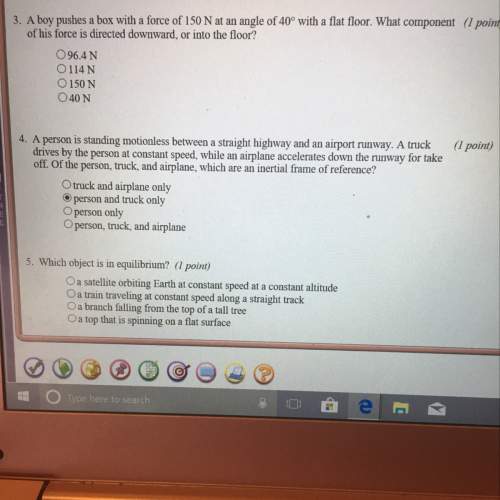
Physics, 22.06.2019 15:30 jonathanmagana112002
Charge is distributed along the entire x-axis with uniform density λ. how much work does the electric field of this charge distribution do on an electron that moves along the y-axis from y = a to y = b? (use the following as necessary: a, b, ε0, λ, and q for the charge on an electron.)

Answers: 3


Other questions on the subject: Physics

Physics, 22.06.2019 00:00, rickevaaaa
Did the proton move into a region of higher potential or lower potential? did the proton move into a region of higher potential or lower potential? because the proton is a negative charge and it accelerates as it travels, it must be moving from a region of higher potential to a region of lower potential. because the proton is a negative charge and it accelerates as it travels, it must be moving from a region of lower potential to a region of higher potential. because the proton is a positive charge and it slows down as it travels, it must be moving from a region of higher potential to a region of lower potential. because the proton is a positive charge and it slows down as it travels, it must be moving from a region of lower potential to a region of higher potential. request answerpart bwhat was the potential difference that stopped the proton? express your answer with the appropriate units.î”v î” v = nothingnothingrequest answerpart cwhat was the initial kinetic energy of the proton, in electron volts? express your answer in electron volts. ki k i = nothing ev request answerprovide feedback
Answers: 2

Physics, 22.06.2019 02:10, kernlife
Astudent is performing an experiment comparing sound and light waves. the student gathers the following data. what conclusion does the student most likely make based on this data? light waves always travel the same speed; however, the speed of sound is determined by the medium that it travels through. all sound waves always have the same energy, so the temperature of the medium does not affect wave speed. light needs to vibrate particles, so it travels fastest in tightly packed solids, while sound does not need a medium, so it travels fastest in a gas. tightly packed particles in solids slow down the light waves; however, sound waves make particles bounce into each other, so they travel faster in solids.
Answers: 3


Physics, 22.06.2019 17:30, brennae1801
The items in the following list are all units of matter. which is the smallest unit that retains the properties of the matter? a.) atom b.) compound c.) electron d.) element
Answers: 1
You know the right answer?
Charge is distributed along the entire x-axis with uniform density λ. how much work does the electri...
Questions in other subjects:

Mathematics, 25.01.2022 19:10

Biology, 25.01.2022 19:20

Mathematics, 25.01.2022 19:20

Physics, 25.01.2022 19:20

History, 25.01.2022 19:20








